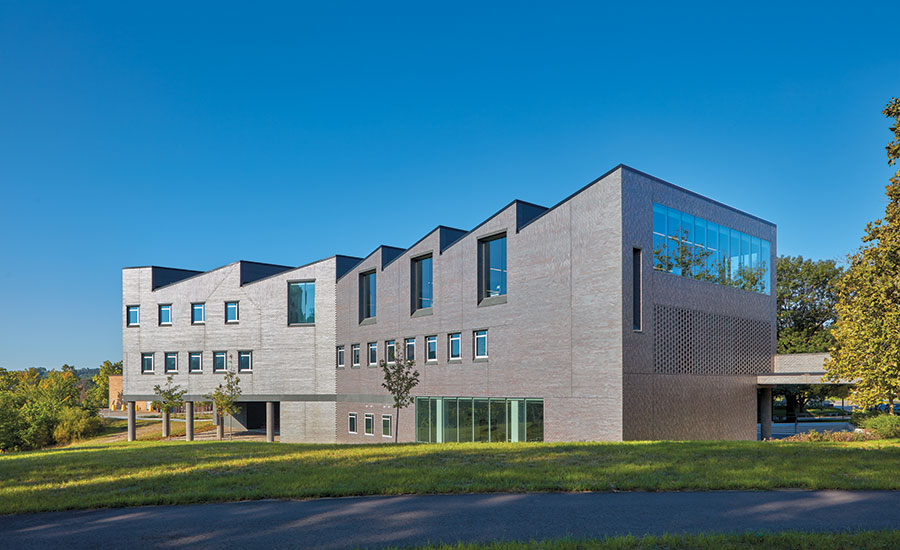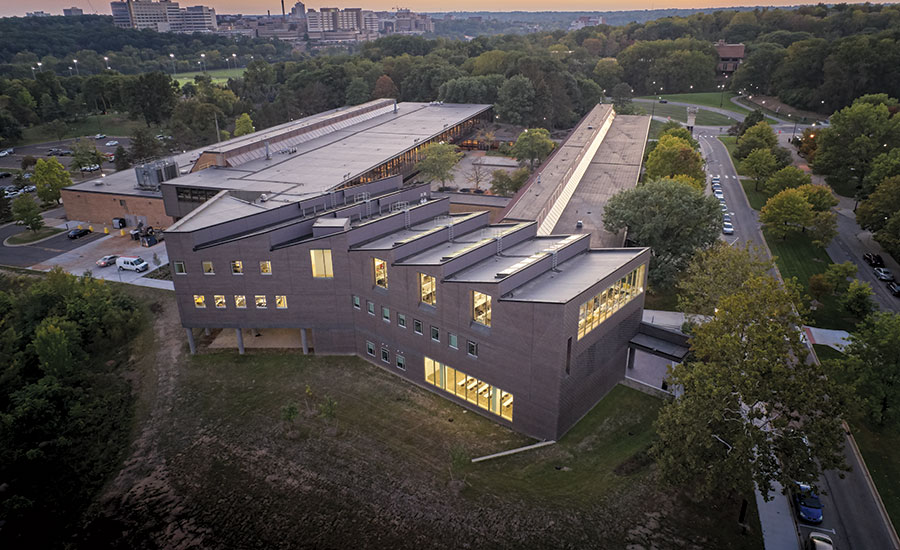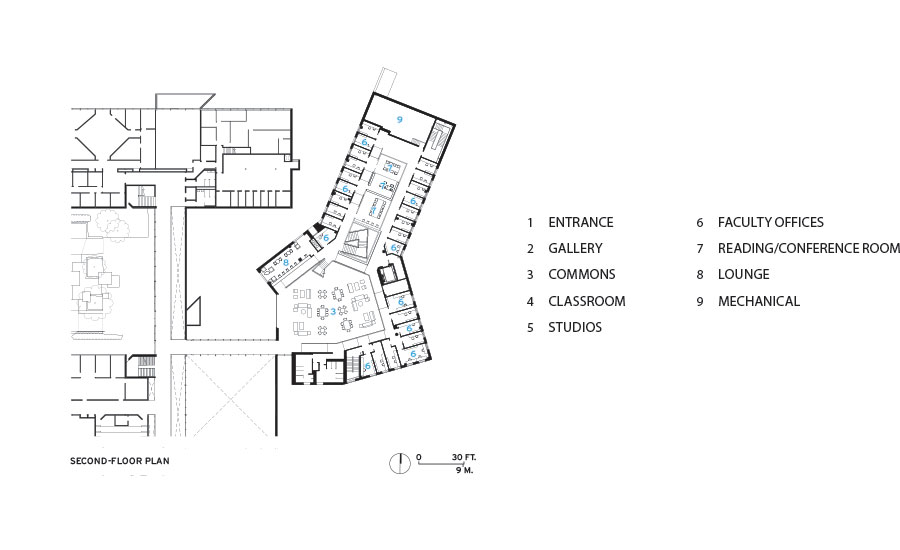A. Alfred Taubman Wing at the University of Michigan by Preston Scott Cohen, Inc.
Ann Arbor, Michigan

South-facing skylights on the sawtooth roof bring light deep into the building, which is clad in a purplish gray semigloss ironspot brick. Behind the glazed wall on the ground floor, a 2,400-square-foot classroom seats 120 students.
Photo © James Haefner

The southwest end of the building deviates from its rectangular form to wrap around the hexagonal commons area.
Photo © James Haefner

A courtyard between new and existing structures creates a natural point of entry to the glazed galleries.
Photo © James Haefner

Thanks to solar analysis and algorithmic modeling, sunlight does not directly strike workspaces in the studios.
Photo © James Haefner

Ramps, stairs, and landings enclose the 5,700-square-foot commons, a flexible space for performances, exhibitions, social activities, conferences, and final reviews.
Photo © James Haefner

Ramps, stairs, and landings enclose the 5,700-square-foot commons, a flexible space for performances, exhibitions, social activities, conferences, and final reviews.
Photo © James Haefner

Image courtesy Preston Scott Cohen, Inc.

Image courtesy Preston Scott Cohen, Inc.

Image courtesy Preston Scott Cohen, Inc.









Architects & Firms
The University of Michigan’s Art and Architecture Building, home of the Taubman College of Architecture and Urban Planning and the Stamps School of Art & Design, has a distinguished lineage. Eliel Saarinen’s grandson, Robert Saarinen Swanson, designed the flat-roofed, low-slung brick courtyard complex in 1974 for a site on Ann Arbor’s leafy North Campus, for which Eero Saarinen had devised an early master plan in the 1950s.
The college recently added another landmark to this legacy with the September opening of the A. Alfred Taubman Wing, designed by Cambridge, Massachusetts–based firm Preston Scott Cohen, Inc. (PSC), in collaboration with Integrated Design Solutions (IDS) of Troy, Michigan, as architect of record. The project includes 36,000 square feet of new construction and 11,000 square feet of renovation, at a total cost of $28.5 million. Highlights of the new facility include a 5,700-square-foot double-height commons and a 5,500-square-foot studio.
Additional Content:
Jump to credits & specifications
The combination of two academic institutions under one roof can cause identity problems. Stamps occupied the frontage along Bonisteel Boulevard and concealed Taubman behind a courtyard, depriving it not only of a direct link to a major campus artery but also of visibility. The new linear wing stretches diagonally to connect Taubman to the street, where it now enjoys a prominent presence. The challenge was to make this appendage, which is off to one side, function as the nexus of circulation for students and faculty. “The goal was to make a center within an edge building,” says design principal Scott Cohen.
At one end, the attenuated addition connects to the original structure via a glass-enclosed bridge tucked beneath an existing cantilever. At the other, it provides a new entrance facing Bonisteel. The acute angle of its placement, however, creates a forced perspective, which funnels people in and gives them the option of using another entrance in a courtyard between new and old. In plan, PSC’s building is a rectangle that splits open to wrap around the new hexagonal commons, which is raised up one level on pilotis to fulfill a requirement that the space below remain open to views of a nearby valley and retention pond. It serves as an outdoor gallery and—less artistically but nonetheless usefully—covered bicycle parking.
Cohen has made his reputation with schemes composed of complex geometries, as seen in the Tel Aviv Museum of Art. But here he wisely decided that both site and budget called for something more modest. Despite these constraints, he has created a bold form with a striking silhouette, sheathed in purplish dark gray semigloss ironspot brick in a pattern that mixes running bond with soldier coursing. Its repetitive sawtooth roof profile articulates a series of skylights, and windows vary in size and shape to signal the scale of the spaces behind them.
The commons is the school’s new hub, intended to bring faculty and students of both architecture and planning together for casual socializing, collaboration, conferences, and final reviews. It’s a dynamic, skylit vertical space encircled by ramps and stairs that lead to studios, lounges, and faculty offices, along with meeting and reading rooms. “The entire sequence,” explains Cohen, “is experienced as a promenade with landings that subtly define social groupings, all with access to natural light and ventilation.” “Everything wraps and shapes it, and it’s full of life,” says the new dean, Jonathan Massey, with evident pride and pleasure. “It’s like an opera house.”
On the third floor, overlooking the commons, is the spacious undergraduate studio, also skylit. “Being up there is like being in a big attic,” says the architect. The room exemplifies his interest in—and skilled hand at—mixing architectural idioms. “The studio combines the loftlike lighting and spatial proportions of a gallery with a midwestern factorylike workspace,” Cohen explains. Generous tall windows provide views in multiple directions. But graduate students should not feel left out: new faculty offices have transformed their old studio by wrapping its perimeter in an elegantly detailed layer of aluminum and glass, and one of its corners has been cut away to provide dramatic views into the commons.
Interior finishes are basic: polished concrete floors and lots of white paint. But the overall effect is incandescent, thanks to skillfully manipulated natural illumination. “The warm color temperature of reflected southern light is the most distinguishing characteristic of the new building,” says Cohen. Contrary to custom, the north faces of the roof’s sawteeth are opaque, and the skylights face south, but sawtooth widths and roof slopes determined by solar analysis and algorithmic modeling prevent sunlight from striking desktops directly. Heat gain is controlled well enough for LEED Gold certification.
Intelligently conceived and artfully lit spatial sequences may be nice, but the ultimate test is how well these new facilities serve the students and faculty who use them. Cohen’s design gets high marks from both. “A lot of schools claim to have integrated architecture and planning curricula,” says professor Richard K. Norton, “but with the collaboration made possible by our new quarters, we really have.” Students seem happy too. “We love all the light,” say several undergraduates of their new studio, though some acknowledge that glare from the big windows is a problem. The commons is an unqualified hit. “You can always be a part of what’s happening,” says one enthusiastic graduate student, “no matter what level you’re on.”
CreditsArchitect: Preston Scott Cohen, Inc. 77 Pleasant Street Cambridge, MA 02139 616-441-2110 http://www.pscohen.com
Personnel in architect's firm who should receive special credit: Preston Scott Cohen, Carl Dworkin, Design Principals
Architect of record: Integrated Design Solutions 1441 West Long Lake, Suite 200 Troy, MI 48098 248-823-2100 http://www.ids-troy.com
Engineers Mechanical and Electrical: Integrated Design Solutions 1441 West Long Lake, Suite 200 Troy, MI 48098 248-823-2100 http://www.ids-troy.com
Structural: SDI Structures 275 East Liberty Ann Arbor, MI 48104 734-213-6091
Landscape and Civil: Beckett and Raider 535 West William, Suite 101 Ann Arbor, MI 48103 734-663-2622 www.bria2.com
General contractor: The Christman Company 208 North Capital Avenue Lansing, MI 48933 517-482-1488
Furniture: Desks Knoll, Inc. 1235 Water Street East Greenville, PA 18041 800-343-5665 www.knoll.com
Supplier: American Interiors 302 S. Byrne Rd. Toledo, OH 43615 419-535-1808 www.americaninteriors.com
Chairs Herman Miller Inc. 855 East Main Ave. PO Box 302 Zeeland, MI 49464 616-654-3000 www.hermanmiller.com
Supplier: MarxModa 463 Patterson Ave SE, Suite A Grand Rapids, MI 49512 855-242-9292 www.marxmoda.com
Photographer: James Haefner |
SpecificationsExterior Cladding Masonry: National Block Company Metal panels: Centria Metal/glass curtain wall: Wausau Window and Wall Systems EIFS, ACM, or other: Marino Wall, Quikrete Moisture barrier: Carlise Sure-Seal Curtain wall: Wausau Window and Wall Systems
Roofing Built-up roofing: Firestone
Windows Metal frame: Wausau Window and Wall Systems
Glazing Glass: Guardian Glass Skylights: SuperSky
Doors Entrances: Wausau Window and Wall Systems Wood doors: Algona Hardwoods, Inc. Sliding doors: McKeon Door Company Fire-control doors, security grilles: SmokeGuard
Hardware Door hardware: Schlage, VonDuprin
Interior Finishes Acoustical ceilings: Armstrong Ceiling Solutions Suspension grid: Armstrong Ceiling Solutions Cabinetwork and custom woodwork: MOD Interiors Paints and stains: Sherman Williams Raised flooring: Haworth Special interior finishes unique to this project – acoustical plaster ceiling: BASWAPhon
Lighting Interior ambient lighting: Lithonia Lighting, Focal Point LLC, Lumen Werx Downlights: Lithonia Lighting, Focal Point LLC, Lumen Werx Tasklighting: Lithonia Lighting, Focal Point LLC, Lumen Werx Exterior: Lithonia Lighting, Focal Point LLC, Lumen Werx Dimming system or other lighting controls: Acuity Controls
Conveyance Elevators/escalators: ThyssenKrupp
Energy Energy management or building automation system: Honeywell. *Note: this project received LEED Gold certification. |














